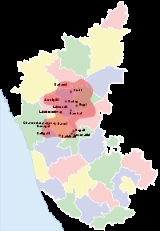
Lakkundi
Encyclopedia
Lakkundi in Gadag District
(North Karnataka
) of Karnataka
is a tiny village on the way to Hampi
(Hospet
) from Hubli. Lakkundi 11 km from Gadag in the east. It is 14 km from Dambal
and 25 km from Mahadeva Temple (Itagi)
.
Lakkundi is a place of antiquarian interest with as many as 50 temples, 101 stepped wells (called Kalyani or Pushkarni) and 29 inscriptions, spread over the period of the later Chalukyas, Kalachuris, Seuna
and the Hoysalas. A great center of Kalyani Chalukyas art, there are several temples of note here. Among them Kasivisvesvara temple, Lakkundi
is the most ornate and elaborately furnished. There is also a Jain Temple dedicated to Mahavira
, the largest and oldest shrines at Lakkundi. There is sculpture gallery (Museum) maintained by the ASI (Archaeological Survey of India
).
Lakkundi also has a darga of Zindeshah Wali.
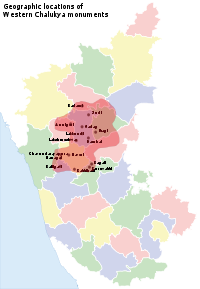
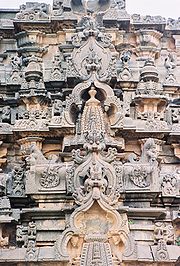
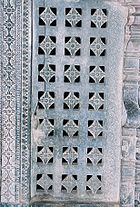
Lakkundi is known for the temple archietecture and Danachintamani Attimabbe
(patronage for Kannada literature and Jainism
).
Other name for Lakkundi was called as LokkiGundi in the inscriptions.
Lakkundi was ruled by later Chalukyas, Kalachuris, Seuna
and the Hoysalas.
The Chalukyas who wrested power from the Rashtrakutas (9th-10th centuries),
made Kalyani their capital. Nothing remains of this city now. Most of the later Chalukya
temples are preserved in Lakkundi,
The Jaina temple at Lakkundi near Gadag forms the next step in the improvement of Kalyani Chalukyas style introducing a greater ornamental effect in the treatment of the surface.
In 12th century, the Kalyani Chalukyas style of architecture reaches its maturity and culmination. Kasivisvesvara temple, Lakkundi
, Mallikarjuna at Kuruvatii and Mahadeva Temple (Itagi)
are the finest examples produced by the later Chalukya architects.
The architecture of the Kalyani Chalukyas of Kalyani
are said to be a link between those of the early Chalukyas of Badami
and the Hoysalas who succeeded them.
Currently Lakkundi has about 50 temples of various stature and antiquity. Some of the temples of note are Halagunda Basavanna Temple, Laxmianarayana Temple, Mallikarjuna Temple, Manikeshwara Temple, Nadayadeva Temple, Nagaradeva Shrine, Neelakanteshwara Temple, Suryanarayana Shrine (of Sun God facing the Kashi Vishweshwara Temple ), Someshwara Temple, Virabhadara Temple, Vishwantha Temple, Virupaksha Temple. Most of them are dedicated to Lord Siva and his various aspects.
Gadag, the district center itself have a few attractive temples. Trikuteshwara Shiva temple is impressive with its intricately ornate pillars, screens of carved stones and friezes.
Attimabbe, known as Danachintamani is a well known personality of the Kalyani Chalukyas period. She made 1000 copies of great poet Ponna's Santi purana and distributed as Sastradana.
The Brahma jinalaya was constructed by Attimabbe. Attimabbe wife of Nagadeva who was the chieftain and soldier of Chalukya King Ahavamalla and mother of Ahniga Masavadi who was ruling Lakkundi for some time.
Attimabbe sheltered the poet Ranna
.
Ajithanatha Purana the details of the construction of the Brahmajinalaya by Attimabbe and the donations.
Lakkundi is often a gem missed by majority of tourists. One take the trouble of making visit to Lakkundi is rewarded with one of the fine architectural feasts of the Kalyana Chalukya period (about 10 century CE).
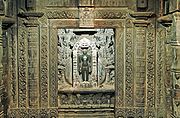
 Brahmajinalaya stands as the testimony of the high rank in the Karnataka
Brahmajinalaya stands as the testimony of the high rank in the Karnataka
temple Archietecture.
Brahma Jainalaya was built by queen Attimabbe is the largest of many Jain temples in Lakkundi. This Basadi is dedicated to Mahavira
, the most revered saint of Jainism
.
This Basadi is perhaps one of the earliest examples of temples in this area built of a kind
of fine textured chloritic schist as distinct from the hitherto used sandstone of this region. The new material, because of its less thick quarry sizes and tractability, reacted on the workmanship, with the result that the masonry courses became reduced in size and the carvings more delicate and highly finished. The temple, perhaps built in the latter half of the eleventh century, has a five-storeyed vimana, square on plan from the base to the sikhara, and had originally a closed square navaranga in front, though an open mandapawas added in front later on.
Basadi has a well fastened Mukha mantapa. and Open hall proped by central pillars
decorated with beautiful carving. The Garbagudi holds the idol of Vardhamana
Mahavira
Tirthankara.
The central bay of the navaranga is a larger square than the peripheral eight around it.
The second storey, as in the Jaina temple at Pattadakal
, is functional and has an antarala-mantapa in front over the vestibule of the lower storey. This raises the total height of the vimana considerably.
A great deal of care has gone into the construction of the Kashivishvanatha temple in Lakkundi
which deifies Shiva
. This temple has a unique feature: a small surya shrine faces the main shrine on the west. There is a common platform between both which must have been an open mandapa originally. Hence the Kashivishvanatha temple has an entrance on the east side and south side of the mandapa. The entrance doorway and the towers are covered with close intricate carving. The shikhara is in the North-India
n style and it looks like a lathe must have been used to make the complex circular pillars.
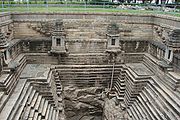 Lakkundi is also noted for its step wells, artistically built with small canopied niches inside the walls of the wells enshrining lingas.
Lakkundi is also noted for its step wells, artistically built with small canopied niches inside the walls of the wells enshrining lingas.
There are numerous ancient wells in Lakkundi, of which the Chateer Bavi, Kanne Bavi and Musukina Bavi are popular for their carvings architectural beauty. Most of the wells are carved with tiny Siva shrines in the form of niches into the walls.
Manikesvara Temple with Stepped Kalyani is one of the Tourist attractions of Lakkundi
At Lakkundi there is a stepped well of the Chalukya period next to the Manikeshwara temple.
On 3 sides of the Kalyani there are steps and The approach to the mandapa of the temples forms
a bridge on the fourth side.
. There are more than 15 Hindu and Jain temples in this town which was a prominent city a thousand years back.
|-
!
|-
|style="text-align: center; width: 100%; " |
|-valign=top
|
|
|}
Gadag District
Gadag District had a population of 971,952 of which 35.21% was urban as of 2001. Population increased 13.14% in the decade 1991-2001. The District is bounded on the north by Bagalkot District, on the east by Koppal District, on the southeast by Bellary District, on the southwest by Haveri...
(North Karnataka
North Karnataka
North Karnataka is an arid plateau from elevation in the Karnataka state of southwest India. It is drained by the Krishna River and its tributaries the Bhima, Ghataprabha, Malaprabha, and Tungabhadra...
) of Karnataka
Karnataka
Karnataka , the land of the Kannadigas, is a state in South West India. It was created on 1 November 1956, with the passing of the States Reorganisation Act and this day is annually celebrated as Karnataka Rajyotsava...
is a tiny village on the way to Hampi
Hampi
Hampi is a village in northern Karnataka state, India. It is located within the ruins of Vijayanagara, the former capital of the Vijayanagara Empire. Predating the city of Vijayanagara, it continues to be an important religious centre, housing the Virupaksha Temple, as well as several other...
(Hospet
Hospet
Hospet , is a city in Bellary District in northern Karnataka, India. It is on the Tungabhadra River, 12 km from the World Heritage site consisting of the ruins of the medieval city of Vijayanagara, former capital of the Vijayanagara Empire....
) from Hubli. Lakkundi 11 km from Gadag in the east. It is 14 km from Dambal
Dambal
Dambal is a village in the Gadag district of the state of Karnataka, India. It was an ancient center of Buddhism and remained so as late as the 12th century.Dambal is at an elevation of 590 metres and its population is 21,096.-History:...
and 25 km from Mahadeva Temple (Itagi)
Mahadeva Temple (Itagi)
Itagi is in Yalburga Taluk, Koppal District, in North Karnataka, Karnataka, India. It is about 7 km from Kuknur. It is near to Lakkundi about 20 km.Itagi is famous for the Chalukya style Mahadeva Temple...
.
Introduction
Lakkundi, full of ruined temples like Mallikarjuna, Virabhadra, Manikeshwara, Nanneshwara, Lakshminarayana, Someshwara, Nilakanteshwara and many more.Lakkundi is a place of antiquarian interest with as many as 50 temples, 101 stepped wells (called Kalyani or Pushkarni) and 29 inscriptions, spread over the period of the later Chalukyas, Kalachuris, Seuna
Seuna
The Seuna, Sevuna or Yadavas of Devagiri was an Indian dynasty, which at its peak ruled a kingdom stretching from the Tungabhadra to the Narmada rivers, including present-day Maharashtra, north Karnataka and parts of Madhya Pradesh, from its capital at Devagiri...
and the Hoysalas. A great center of Kalyani Chalukyas art, there are several temples of note here. Among them Kasivisvesvara temple, Lakkundi
Kasivisvesvara temple, Lakkundi
The Kasivisvesvara temple and sometimes called Kashivishvanatha temple is located in Lakkundi , Karnataka state, India...
is the most ornate and elaborately furnished. There is also a Jain Temple dedicated to Mahavira
Mahavira
Mahāvīra is the name most commonly used to refer to the Indian sage Vardhamāna who established what are today considered to be the central tenets of Jainism. According to Jain tradition, he was the 24th and the last Tirthankara. In Tamil, he is referred to as Arukaṉ or Arukadevan...
, the largest and oldest shrines at Lakkundi. There is sculpture gallery (Museum) maintained by the ASI (Archaeological Survey of India
Archaeological Survey of India
The Archaeological Survey of India is a department of the Government of India, attached to the Ministry of Culture . The ASI is responsible for archaeological studies and the preservation of archaeological heritage of the country in accordance with the various acts of the Indian Parliament...
).
Lakkundi also has a darga of Zindeshah Wali.
History



Lakkundi is known for the temple archietecture and Danachintamani Attimabbe
(patronage for Kannada literature and Jainism
Jainism
Jainism is an Indian religion that prescribes a path of non-violence towards all living beings. Its philosophy and practice emphasize the necessity of self-effort to move the soul towards divine consciousness and liberation. Any soul that has conquered its own inner enemies and achieved the state...
).
Other name for Lakkundi was called as LokkiGundi in the inscriptions.
Lakkundi was ruled by later Chalukyas, Kalachuris, Seuna
Seuna
The Seuna, Sevuna or Yadavas of Devagiri was an Indian dynasty, which at its peak ruled a kingdom stretching from the Tungabhadra to the Narmada rivers, including present-day Maharashtra, north Karnataka and parts of Madhya Pradesh, from its capital at Devagiri...
and the Hoysalas.
The Chalukyas who wrested power from the Rashtrakutas (9th-10th centuries),
made Kalyani their capital. Nothing remains of this city now. Most of the later Chalukya
temples are preserved in Lakkundi,
The Jaina temple at Lakkundi near Gadag forms the next step in the improvement of Kalyani Chalukyas style introducing a greater ornamental effect in the treatment of the surface.
In 12th century, the Kalyani Chalukyas style of architecture reaches its maturity and culmination. Kasivisvesvara temple, Lakkundi
Kasivisvesvara temple, Lakkundi
The Kasivisvesvara temple and sometimes called Kashivishvanatha temple is located in Lakkundi , Karnataka state, India...
, Mallikarjuna at Kuruvatii and Mahadeva Temple (Itagi)
Mahadeva Temple (Itagi)
Itagi is in Yalburga Taluk, Koppal District, in North Karnataka, Karnataka, India. It is about 7 km from Kuknur. It is near to Lakkundi about 20 km.Itagi is famous for the Chalukya style Mahadeva Temple...
are the finest examples produced by the later Chalukya architects.
The architecture of the Kalyani Chalukyas of Kalyani
Basavakalyan
Basavakalyan is a town in Bidar District of the state of Karnataka, India, and was historically known as Kalyan.-History:Basavakalyan's history dates back to 3000 years with its name being mentioned in Guru Charitra....
are said to be a link between those of the early Chalukyas of Badami
Badami
Badami , formerly known as Vatapi, is a town and headquarters of a taluk by the same name, in the Bagalkot district of Karnataka, India. It was the regal capital of the Badami Chalukyas from 540 to 757 AD. It is famous for rock cut and other structural temples...
and the Hoysalas who succeeded them.
Temples
At Lakkundi all the temples are made of green schist and the outer walls and entrances are very richly decorated. The shikhara is an in-between-style type and the parapet and the artistic division of the wall with pilasters is typical of the south-Indian style.Currently Lakkundi has about 50 temples of various stature and antiquity. Some of the temples of note are Halagunda Basavanna Temple, Laxmianarayana Temple, Mallikarjuna Temple, Manikeshwara Temple, Nadayadeva Temple, Nagaradeva Shrine, Neelakanteshwara Temple, Suryanarayana Shrine (of Sun God facing the Kashi Vishweshwara Temple ), Someshwara Temple, Virabhadara Temple, Vishwantha Temple, Virupaksha Temple. Most of them are dedicated to Lord Siva and his various aspects.
Gadag, the district center itself have a few attractive temples. Trikuteshwara Shiva temple is impressive with its intricately ornate pillars, screens of carved stones and friezes.
Attimabbe
Attimabbe built a Jain temple at Lakkundi to which the king (Satyasraya) provided a golden Kalasa.Attimabbe, known as Danachintamani is a well known personality of the Kalyani Chalukyas period. She made 1000 copies of great poet Ponna's Santi purana and distributed as Sastradana.
The Brahma jinalaya was constructed by Attimabbe. Attimabbe wife of Nagadeva who was the chieftain and soldier of Chalukya King Ahavamalla and mother of Ahniga Masavadi who was ruling Lakkundi for some time.
Attimabbe sheltered the poet Ranna
Ranna
Ranna was one of the earliest poets of Kannada language.Ranna, Adikavi Pampa and Sri Ponna together are called "three gems of Kannada literature".-Early days:Ranna was born on 949 C.E. in Muduvolalu Bagalkot district, Karnataka....
.
Inscriptions
Lakkundi is also a treasure house of many important Inscriptions (about 29).- The inscriptions of the Kalyani Chalukyas king Irive Bedanga narrates in
Ajithanatha Purana the details of the construction of the Brahmajinalaya by Attimabbe and the donations.
- The inscriptions of the KalachuriKalachuriKalachuri Empire is this the name used by two kingdoms who had a succession of dynasties from the 10th-12th centuries, one ruling over areas in Central India and were called Chedi or Haihaya and the other southern Kalachuri who ruled over parts of Karnataka...
King Sovideva (1173 A.D.) reveals the donation of gold to a Basadi by Gunanidi Keshava. - The important inscriptions of Kalyani Chalukyas Somashekara VI (1185 A.D.), reveals the donation for conducting Ashtavidharchana. And other 12th century period inscription mentions the donation of land to Tribhuvana tilaka Shantinatha. Also an inscription mentions the existence of Jain saints Mulasangha Devanga.
Tourism
Lakkundi is known for the Chalukya style temples, stepped wells and historic inscriptions. Owing to its uniqueness, sometimes these temples are simply referred to as Kalyani Chalukyas Temples.Lakkundi is often a gem missed by majority of tourists. One take the trouble of making visit to Lakkundi is rewarded with one of the fine architectural feasts of the Kalyana Chalukya period (about 10 century CE).
Brahma Jinalaya (Basadi)


Karnataka
Karnataka , the land of the Kannadigas, is a state in South West India. It was created on 1 November 1956, with the passing of the States Reorganisation Act and this day is annually celebrated as Karnataka Rajyotsava...
temple Archietecture.
Brahma Jainalaya was built by queen Attimabbe is the largest of many Jain temples in Lakkundi. This Basadi is dedicated to Mahavira
Mahavira
Mahāvīra is the name most commonly used to refer to the Indian sage Vardhamāna who established what are today considered to be the central tenets of Jainism. According to Jain tradition, he was the 24th and the last Tirthankara. In Tamil, he is referred to as Arukaṉ or Arukadevan...
, the most revered saint of Jainism
Jainism
Jainism is an Indian religion that prescribes a path of non-violence towards all living beings. Its philosophy and practice emphasize the necessity of self-effort to move the soul towards divine consciousness and liberation. Any soul that has conquered its own inner enemies and achieved the state...
.
This Basadi is perhaps one of the earliest examples of temples in this area built of a kind
of fine textured chloritic schist as distinct from the hitherto used sandstone of this region. The new material, because of its less thick quarry sizes and tractability, reacted on the workmanship, with the result that the masonry courses became reduced in size and the carvings more delicate and highly finished. The temple, perhaps built in the latter half of the eleventh century, has a five-storeyed vimana, square on plan from the base to the sikhara, and had originally a closed square navaranga in front, though an open mandapawas added in front later on.
Basadi has a well fastened Mukha mantapa. and Open hall proped by central pillars
decorated with beautiful carving. The Garbagudi holds the idol of Vardhamana
Mahavira
Mahavira
Mahāvīra is the name most commonly used to refer to the Indian sage Vardhamāna who established what are today considered to be the central tenets of Jainism. According to Jain tradition, he was the 24th and the last Tirthankara. In Tamil, he is referred to as Arukaṉ or Arukadevan...
Tirthankara.
The central bay of the navaranga is a larger square than the peripheral eight around it.
The second storey, as in the Jaina temple at Pattadakal
Pattadakal
Pattadakal is a village in Karnataka. It lies on the banks of the Malaprabha River in Bagalkot district. It is 22 km from Badami and about 10 km from Aihole...
, is functional and has an antarala-mantapa in front over the vestibule of the lower storey. This raises the total height of the vimana considerably.
Kashivishvanatha Temple
Kashi Vishweshwara Temple, dedicated to Lord Shiva is meticulous for its carvings on the towers and the doorways. The heavy circular pillars were made using some kind of lathe.A great deal of care has gone into the construction of the Kashivishvanatha temple in Lakkundi
which deifies Shiva
Shiva
Shiva is a major Hindu deity, and is the destroyer god or transformer among the Trimurti, the Hindu Trinity of the primary aspects of the divine. God Shiva is a yogi who has notice of everything that happens in the world and is the main aspect of life. Yet one with great power lives a life of a...
. This temple has a unique feature: a small surya shrine faces the main shrine on the west. There is a common platform between both which must have been an open mandapa originally. Hence the Kashivishvanatha temple has an entrance on the east side and south side of the mandapa. The entrance doorway and the towers are covered with close intricate carving. The shikhara is in the North-India
India
India , officially the Republic of India , is a country in South Asia. It is the seventh-largest country by geographical area, the second-most populous country with over 1.2 billion people, and the most populous democracy in the world...
n style and it looks like a lathe must have been used to make the complex circular pillars.
Nanneshwara Temple
Nanneshwara Temple located to its north is worth a visit. This temple looks like a simple and small replica of the much elaborate Kashi Vishweshwara Temple. Probably the Nanneshwara Temple was built as a prototype before the grand Kashi Vishweshwara Temple was executed.Stepped wells

There are numerous ancient wells in Lakkundi, of which the Chateer Bavi, Kanne Bavi and Musukina Bavi are popular for their carvings architectural beauty. Most of the wells are carved with tiny Siva shrines in the form of niches into the walls.
Manikesvara Temple with Stepped Kalyani is one of the Tourist attractions of Lakkundi
At Lakkundi there is a stepped well of the Chalukya period next to the Manikeshwara temple.
On 3 sides of the Kalyani there are steps and The approach to the mandapa of the temples forms
a bridge on the fourth side.
Weaving of Ambasi panje
Contrast bordered Lungi (Ambasi Phadiki Dhadi Panje) woven at Lakkundi, the Dhoti (Lingi), daily wear woven with a contrast border using traditional motifs.Transport
Once you get dropped at the Lakkundi bus stand, you can practically cover all the temples and other monuments on foot. Nevertheless you can hire a local taxi for better convenience.KuknurKuknur
Kuknur is in Yalaburga taluk in Koppal District, is a small town. is located about 40 km from Hospet and 7 km from Mahadeva Temple , Kuknur is renowned for its temples of the Rastrakutas and Chalukyas times, of these the Navalinga group of temples is famous.-History:Kuknur town was an...
. There are more than 15 Hindu and Jain temples in this town which was a prominent city a thousand years back.
Gallery
{| class="wikitable collapsible collapsed" style="border-color:transparent; background: transparent; width: 100%; margin: 0; text-align: center;" align="center"|-
!
|-
|style="text-align: center; width: 100%; " |
See also
{||-valign=top
|
- Western Chalukya templesWestern Chalukya templesSome famous temples built by the Western Chalukyas are included in the table below.-References:...
- Western Chalukya architectureWestern Chalukya architectureWestern Chalukya architecture , also known as Kalyani Chalukya or Later Chalukya architecture, is the distinctive style of ornamented architecture that evolved during the rule of the Western Chalukya Empire in the Tungabhadra region of central Karnataka, India, during the 11th and 12th centuries...
- Western Chalukya Empire
- AnnigeriAnnigeriAnnigeri is a town in Navalgund taluk of Dharwad district in the state of Karnataka, India, located 20 km west of Gadag en route to Hubli and 35 km from Hubli-Dharwad.-Introduction:...
- DambalDambalDambal is a village in the Gadag district of the state of Karnataka, India. It was an ancient center of Buddhism and remained so as late as the 12th century.Dambal is at an elevation of 590 metres and its population is 21,096.-History:...
- Gadag
- Mahadeva Temple (Itagi)Mahadeva Temple (Itagi)Itagi is in Yalburga Taluk, Koppal District, in North Karnataka, Karnataka, India. It is about 7 km from Kuknur. It is near to Lakkundi about 20 km.Itagi is famous for the Chalukya style Mahadeva Temple...
- KuknurKuknurKuknur is in Yalaburga taluk in Koppal District, is a small town. is located about 40 km from Hospet and 7 km from Mahadeva Temple , Kuknur is renowned for its temples of the Rastrakutas and Chalukyas times, of these the Navalinga group of temples is famous.-History:Kuknur town was an...
|
- LakshmeshwarLakshmeshwarLakshmeshwara is a town in Shirahatti taluk, Gadag district, North Karnataka, in the Indian state of Karnataka. It is about 50 km from Gadag and 55 km from Hubli. Lakshmeshwara is an agricultural trading town....
- KundgolKundgolKundgol is a panchayat town in Dharwad district in the Indian state of Karnataka.-Introduction:Kundgol is Located in Dharwad District of Karnataka is about 14 km south-west of Hubli and 32 km south-west of Dharwad....
- HaveriHaveriHaveriis a town in Karnataka. It is the administrative headquarters of Haveri District. The name Haveri is derived from the Kannada words havu and keri, which means place of snakes. Haveri is famous for its cardamom garlands. It is said that Haveri had around 1000 maths in ancient days. One of...
- SudiSudiSudi , is a panchayat town in the Gadag District of Karnataka, India. It is about 30 km from Badami, 12 km from Gajendragad and 3 km from Itagi Bhimambika temple. In the past it was a important town of the Kalyani Chalukyas during 1000 AD...
- North KarnatakaNorth KarnatakaNorth Karnataka is an arid plateau from elevation in the Karnataka state of southwest India. It is drained by the Krishna River and its tributaries the Bhima, Ghataprabha, Malaprabha, and Tungabhadra...
- Tourism in North Karnataka
- Temples of North KarnatakaTemples of North KarnatakaTemples of North KarnatakaNorth Karnataka has innumerable sites in the Temple Map of Karnataka, India, with its some of its still surviving monuments going back to the 7th century AD. The Badami Chalukyas were the builders of rock cut caves and ancient temple complexes...
|}
Architecture References
- Western Chalukya architectureWestern Chalukya architectureWestern Chalukya architecture , also known as Kalyani Chalukya or Later Chalukya architecture, is the distinctive style of ornamented architecture that evolved during the rule of the Western Chalukya Empire in the Tungabhadra region of central Karnataka, India, during the 11th and 12th centuries...
- Hindu temple architectureHindu temple architectureIndia's temple architecture developed from the sthapathis' and shilpis' creativit, but n general these are from the Vishwakarma . A small Hindu temple consists of an inner sanctum, the garbha griha or womb-chamber, in which the image is housed, often circumambulation, a congregation hall, and...
- Hoysala architectureHoysala architectureHoysala architecture is the building style developed under the rule of the Hoysala Empire between the 11th and 14th centuries, in the region known today as Karnataka, a state of India. Hoysala influence was at its peak in the 13th century, when it dominated the Southern Deccan Plateau region...
- Vijayanagara architecture
- Badami Chalukya architectureBadami Chalukya ArchitectureThe Badami Chalukya architecture was a temple building idiom that evolved in the time period of 5th – 8th centuries AD. in the area of Malaprabha basin, in present day Bagalkot district of Karnataka state. This style is sometimes called the Vesara style and Chalukya style...
- Dravidian architectureDravidian architectureDravidian architecture was a style of architecture that emerged thousands of years ago in Southern part of the Indian subcontinent or South India. They consist primarily of pyramid shaped temples called Koils which are dependent on intricate carved stone in order to create a step design consisting...

